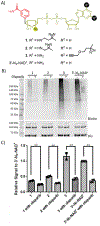A Bifunctional NAD+ for Profiling Poly-ADP-Ribosylation-Dependent Interacting Proteins
- PMID: 33524253
- PMCID: PMC7909001
- DOI: 10.1021/acschembio.0c00937
A Bifunctional NAD+ for Profiling Poly-ADP-Ribosylation-Dependent Interacting Proteins
Abstract
Protein poly-ADP-ribosylation (PARylation) is a heterogeneous and dynamic post-translational modification regulated by various writers, readers, and erasers. It participates in a variety of biological events and is involved in many human diseases. Currently, tools and technologies have yet to be developed for unambiguously defining readers and erasers of individual PARylated proteins or cognate PARylated proteins for known readers and erasers. Here, we report the generation of a bifunctional nicotinamide adenine dinucleotide (NAD+) characterized by diazirine-modified adenine and clickable ribose. By serving as an excellent substrate for poly-ADP-ribose polymerase 1 (PARP1)-catalyzed PARylation, the generated bifunctional NAD+ enables photo-cross-linking and enrichment of PARylation-dependent interacting proteins for proteomic identification. This bifunctional NAD+ provides an important tool for mapping cellular interaction networks centered on protein PARylation, which are essential for elucidating the roles of PARylation-based signals or activities in physiological and pathophysiological processes.
Conflict of interest statement
Conflict of Interest Disclosure
The authors declare no competing financial interests.
Figures




References
-
- Pleschke JM, Kleczkowska HE, Strohm M, and Althaus FR (2000) Poly(ADP-ribose) binds to specific domains in DNA damage checkpoint proteins, J. Biol. Chem 275, 40974–40980. - PubMed
-
- Rack JG, Perina D, and Ahel I (2016) Macrodomains: Structure, Function, Evolution, and Catalytic Activities, Annu. Rev. Biochem 85, 431–454. - PubMed
Publication types
MeSH terms
Substances
Grants and funding
LinkOut - more resources
Full Text Sources
Other Literature Sources
Miscellaneous

